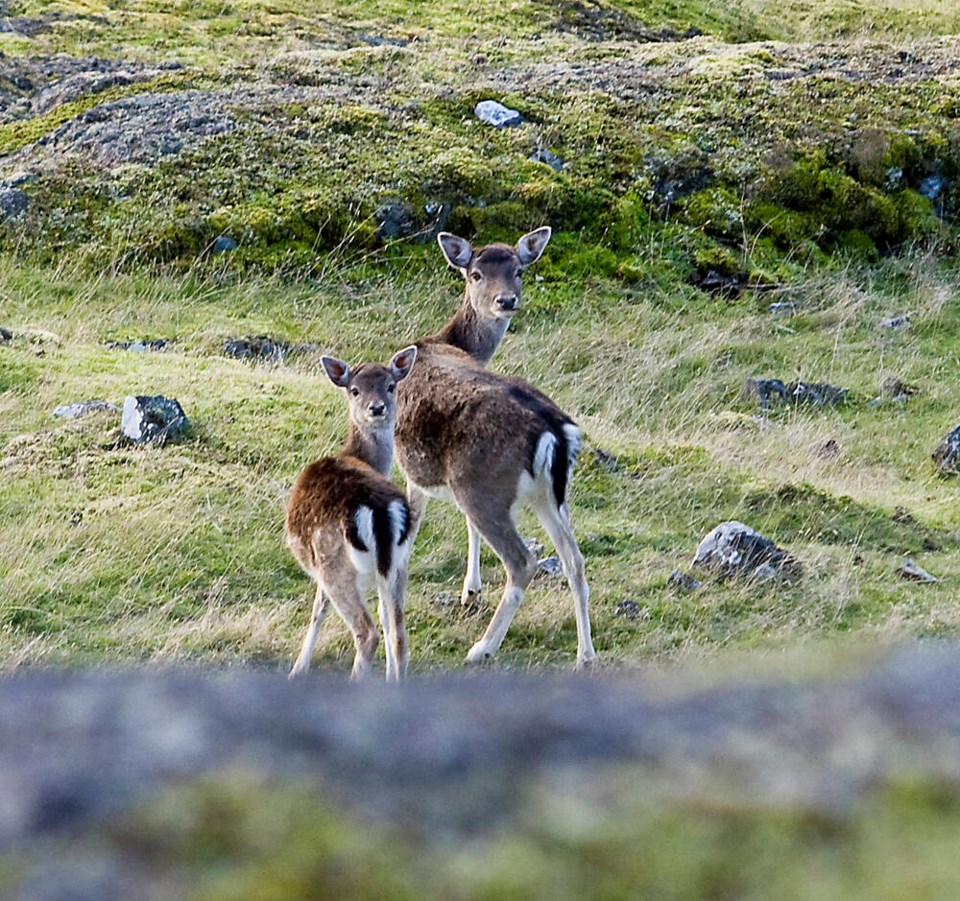A plan to round up and kill all the fallow deer on Sidney Island is on hold after a vote by property owners on the small island failed to meet the threshold to pass.
The vote threshold to proceed with the mass kill was set at 75% by the Sallas Forest Strata Corp., but the resolution only received 55% of the vote on May 4.
The strata council said in a statement Wednesday that a group of owners has filed a claim with the Civil Resolution Tribunal challenging the 75 per cent vote threshold, which means the outcome is uncertain.
“Sallas will not formally inform Parks [sa国际传媒] of the vote outcome until the vote threshold decision has been ruled on by a tribunal of competent jurisdiction.”
sa国际传媒’s Civil Resolution Tribunal is set up to resolve disputes without a court and encourages a collaborative approach to resolving disputes. Members are independent legal experts, and their decisions can be enforced.
Parks sa国际传媒, property owners and First Nations started planning the eradication of European fallow deer on Sidney Island last year as part of an effort to restore native plants and undo decades of damage.
But the final word on whether to proceed with the cull was left with Sallas Forest Strata Corp., made up of Sidney Island property owners, who own 1,500 hectares in 111 bare-land strata lots.
Triana Newton, spokeswoman for the Sallas Forest Strata, said Wednesday she would not discuss the results of the vote.
“This issue has a broad spectrum of views throughout our community,” Newton said in an emailed statement. “We have been on a journey as a community to have the required vote to determine our involvement (or non involvement) in the Sidney Island ecological restoration project.”
Parks sa国际传媒, which controls about 440 hectares on the north end of the island — including Sidney Spit — as part of Gulf Islands National Park Reserve, is leading the cull initiative, along with the First Nations of the W瘫SÁNE膯 Leadership Council, Islands Trust Conservancy and island residents.
A mass killing of the deer is a touchy subject with strata owners, who have been split between those who want to be rid of the deer and preserve the natural ecosystem and others who want to continue hunting the fallow deer through a seasonal licensing program.
Michael Janssen of Parks sa国际传媒 said Wednesday any plan for a potential cull was “in limbo” following the residents’ vote.
“If the community doesn’t support it, Parks sa国际传媒 will not go ahead with it,” said Janssen.
Janssen said Parks sa国际传媒 solicited bids for a contract to develop the eradication operational plan, and will implement it on Sidney Island if supported by project partners.
The fallow deer were introduced on neighbouring James Island in 1902 by the owner at the time as prey for hunting parties. The spotted deer with impressive antlers invaded Sidney Island in the early 1960s, when ponds were dug and the first standing fresh water became available to sustain them.
Their numbers grew to the thousands in the 1980s, damaging Sidney Island’s Garry oak meadows, Douglas firs and dozens of native plant species.
Controlled hunting and periodic culls over the years have reduced their numbers to an estimated 400 to 500.
Sidney Island is about 2,400 hectares and is unceded territory of the Coast Salish First Nations.
Parks sa国际传媒 said the eradication of fallow deer is essential to restore the natural ecology on Sidney Island and aid native plant recovery that will support insects, butterflies, songbirds, rodents and black-tailed deer. Sidney Island is considered one of the least ecologically diverse islands in the Gulf Islands because of the deer, said Janssen.
Eric Pelkey, hereditary chief of the Tsawout Nation and representative of the W瘫SÁNE膯 Leadership Council, told the sa国际传媒 last spring that First Nations want to see the island return to the natural state it was in when his ancestors had an active village and burial grounds there, edible and medicinal plants such as camas and ferns were plentiful and native black-tailed deer caused far less damage.
Parks sa国际传媒 has said it would use an internationally accredited firm to carry out the mass kill in the most humane manner, though all the parties admit it would still be a gruesome task.
Pelkey said the process would involve netting and penning the deer to be killed quickly. He said hunting dogs and possibly helicopters would be used to round up or hunt remnants of herds.
In 2017, the federal government announced it was spending $5.7 million over three years to eradicate introduced deer on six islands on Haida Gwaii, and that included the hiring of sharpshooters to fire from helicopters, boats and on the ground with tracking dogs.



